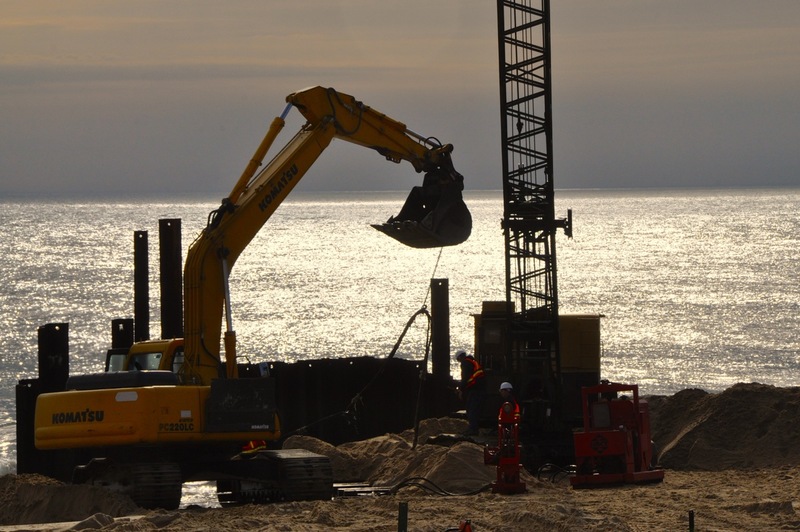No timeline has been set to repair the damage brought by Hurricane Sandy to Rehoboth Beach, but state and federal officials say all of the Cape Region's famous beaches will be restored.
Tony Pratt, administrator of the Department of Natural Resources and Environmental Control's Shoreline and Waterways Division, said the U.S. Army Corps of Engineers intends to repair Rehoboth Beach and other Delaware beaches to where they were before Hurricane Sandy. He said the corps has prepared contracts, but the project has not yet been put out for bid.
The planned repairs will be 100 percent funded by the federal government as part of the $50 million relief bill signed by President Barack Obama Jan. 29.
Pratt said the first in line for repair is the beach area north of Indian River Inlet, which has not previously been nourished.
In Rehoboth and Dewey Beach, the work will restore the beach to pre-storm levels, using the same template used during the Feburary 2012 beach replenishment, eight months before Sandy arrived. The corps has estimated that Rehoboth and Dewey lost a combined 270,000 cubic yards of sand during the storm, nearly a quarter of the 1,033,000 cubic yards of sand pumped onto Rehoboth and Dewey during the 2012 replenishment.
Pratt said the dunes protecting Rehoboth’s Boardwalk will not require significant restoration. The only area where Sandy’s waves topped the dunes was at the north end of the Boardwalk. Pratt said if the dune had been lowered, the roots of the beach grass would have been exposed and the grass itself would be gone. Nearly all grass is still in place, he said, meaning the north-end dune is somewhat flatter, but it was not lowered.
“I think we’re in pretty good shape there,” Pratt said.
While DNREC would not have a financial role in the corps’ beach restoration efforts, Pratt said the department would still monitor the project, because the state is usually a 35 percent partner in beach replenishment.
At a talk to the Rehoboth Beach-Dewey Beach Chamber of Commerce at Kings Creek Country Club April 16, Pratt updated local businesspeople on the status of beach repair and discussed the importance beach renourishment for business.
“Beaches are the heart and soul of our businesses,” he said.
Pratt said in 2004, the summer before a major beach renourishment, Rehoboth had only 20 to 25 feet of dry sand.
“What we know from economic analysis is people who come from afar and want to spend their hard-earned dollars and precious free time at a beach community are going to want something a little more than 20 feet of dry sand,” he said.
In 2005, the state and federal government widened the beaches, including Fenwick Island, South Bethany, Bethany Beach, Dewey Beach and Rehoboth.
Pratt said a 2007 DNREC study Rehoboth draws on a potential visitor population, not including day visitors within 50 miles, of 4.7 million people. Visitors annually spent $665 million at the beach at the time of the study. State and federal officials have spent $50 million to $60 million to widen the beaches since 2005.
“It’s staggering the economic stimulus that comes,” Pratt said. “It’s a good investment. This is an important sector that needs to be protected.”
Pratt said DNREC estimated the economic losses over a five-year period if the beaches had not been renourished would have been $90 million, losing 271,000 visitors over that same period. He said the cost to local business profits was estimated at $6 million.
Still, Pratt said, future federal funding is not a sure thing. He said if federal funding were to disappear, the beaches would gradually lose sand and eventually go back to the way things were in 2004.
Despite uncertainty over future funding, Pratt said the wider beaches did their job to protect shoreline development from Sandy.
“At the end of the day, Rehoboth had lights on, the streets were dry on the ocean side. We held tight on the ocean, except for a three-quarter mile segment north of Indian River Inlet. And that’s really quite remarkable with a storm as intense as Sandy was.”
Ryan Mavity covers Milton and the court system. He is married to Rachel Swick Mavity and has two kids, Alex and Jane. Ryan started with the Cape Gazette all the way back in February 2007, previously covering the City of Rehoboth Beach. A native of Easton, Md. and graduate of Towson University, Ryan enjoys watching the Baltimore Ravens, Washington Capitals and Baltimore Orioles in his spare time.






















































